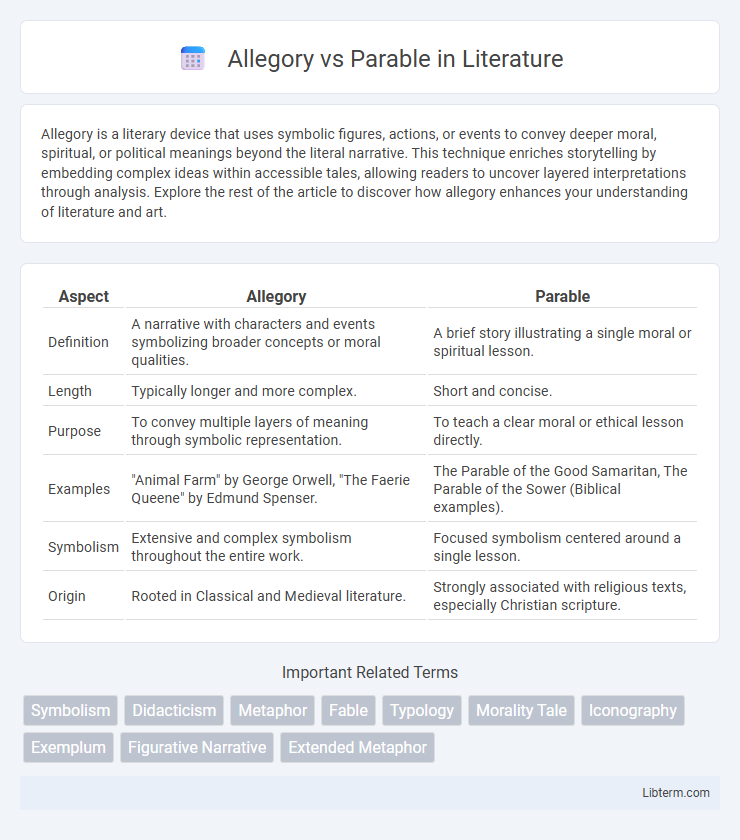Allegory is a literary device that uses symbolic figures, actions, or events to convey deeper moral, spiritual, or political meanings beyond the literal narrative. This technique enriches storytelling by embedding complex ideas within accessible tales, allowing readers to uncover layered interpretations through analysis. Explore the rest of the article to discover how allegory enhances your understanding of literature and art.
Table of Comparison
| Aspect | Allegory | Parable |
|---|---|---|
| Definition | A narrative with characters and events symbolizing broader concepts or moral qualities. | A brief story illustrating a single moral or spiritual lesson. |
| Length | Typically longer and more complex. | Short and concise. |
| Purpose | To convey multiple layers of meaning through symbolic representation. | To teach a clear moral or ethical lesson directly. |
| Examples | "Animal Farm" by George Orwell, "The Faerie Queene" by Edmund Spenser. | The Parable of the Good Samaritan, The Parable of the Sower (Biblical examples). |
| Symbolism | Extensive and complex symbolism throughout the entire work. | Focused symbolism centered around a single lesson. |
| Origin | Rooted in Classical and Medieval literature. | Strongly associated with religious texts, especially Christian scripture. |
Introduction to Allegory and Parable
Allegory is a narrative technique where characters, events, and settings symbolically represent abstract ideas or moral qualities, often conveying complex messages through extended metaphor. Parables are brief stories that illustrate a moral or spiritual lesson, typically simple and straightforward in structure. Both forms use symbolism, but allegories tend to be more intricate and layered, while parables emphasize clear, instructive lessons.
Defining Allegory
An allegory is a narrative technique in which characters, events, and settings symbolically represent abstract ideas or moral qualities, conveying a deeper meaning beyond the literal story. Unlike a simple parable that conveys a single moral lesson, an allegory typically encompasses complex and multifaceted themes throughout the entire work. Classic examples of allegories include George Orwell's "Animal Farm" and John Bunyan's "The Pilgrim's Progress," both illustrating political and spiritual concepts through symbolic storytelling.
Defining Parable
A parable is a succinct, simple story used to illustrate a moral or spiritual lesson, often found in religious texts and teachings. It relies on relatable, everyday scenarios to convey deeper ethical meanings without the complexity of extensive symbolism. Unlike allegories, which use a broader and more intricate symbolic framework, parables focus on clear, direct messaging to guide understanding.
Key Differences Between Allegory and Parable
Allegories use extended narratives with multiple layers of meaning to convey complex moral, political, or spiritual messages, while parables present brief, straightforward stories with a single clear lesson. Allegories often feature symbolic characters and events representing broader concepts or ideologies, whereas parables rely on simple, relatable scenarios to illustrate a specific ethical or religious teaching. The key difference lies in allegory's multi-dimensional symbolism compared to the parable's concise, didactic nature.
Purpose and Function in Literature
Allegory serves as an extended metaphor where characters and events symbolize broader concepts, aiming to reveal complex moral, political, or spiritual truths throughout the narrative. Parables use succinct, simple stories to convey a specific moral lesson or ethical principle, often relying on clear, straightforward messages. Both function to instruct and provoke reflection but differ in scope and depth, with allegories embedding multiple layers of meaning and parables focusing on singular, direct teachings.
Historical Origins and Evolution
Allegory and parable both originated in ancient literature, with allegory tracing back to Greek philosophy and works like Plato's "Allegory of the Cave," emphasizing symbolic representation to convey complex ideas. Parables emerged prominently in religious texts, notably in the New Testament, where Jesus used simple, illustrative stories to teach moral lessons. Over time, allegories evolved into sophisticated narrative frameworks in medieval and Renaissance art and literature, while parables maintained their role in ethical and spiritual instruction across cultures.
Famous Examples of Allegory
Famous examples of allegory include George Orwell's "Animal Farm," which uses farm animals to represent the Russian Revolution and critique totalitarian regimes, and John Bunyan's "The Pilgrim's Progress," a religious allegory depicting the spiritual journey of its protagonist, Christian. Another notable allegory is Plato's "Allegory of the Cave," illustrating the difference between perception and reality through prisoners in a cave. These works employ symbolic characters and narratives to convey deeper moral, political, or philosophical meanings beyond their literal stories.
Notable Examples of Parable
Notable examples of parables include the Parable of the Good Samaritan, illustrating compassion beyond social boundaries, and the Parable of the Prodigal Son, highlighting forgiveness and redemption. These short, simple stories use human characters and everyday situations to convey moral lessons, differentiating them from allegories that often feature extended symbolic narratives. Parables are commonly found in religious texts like the Bible, serving as effective tools for teaching ethical principles through relatable scenarios.
Interpreting Allegories and Parables
Interpreting allegories requires analyzing multiple layers of meaning, where characters and events symbolically represent broader concepts or moral truths. Parables focus on a singular, straightforward lesson, often using simple narratives to convey ethical or spiritual teachings. Understanding context and cultural background is essential for accurately decoding both forms, yet allegories typically demand deeper symbolic interpretation compared to the more direct message found in parables.
Conclusion: Choosing Between Allegory and Parable
Choosing between allegory and parable depends on the desired depth and complexity of the message. Allegories offer multi-layered symbolism suited for exploring abstract or universal themes, while parables provide straightforward narratives with clear moral or spiritual lessons. Understanding the target audience's preference for either intricate interpretation or direct guidance helps in selecting the most effective storytelling form.
Allegory Infographic

 libterm.com
libterm.com